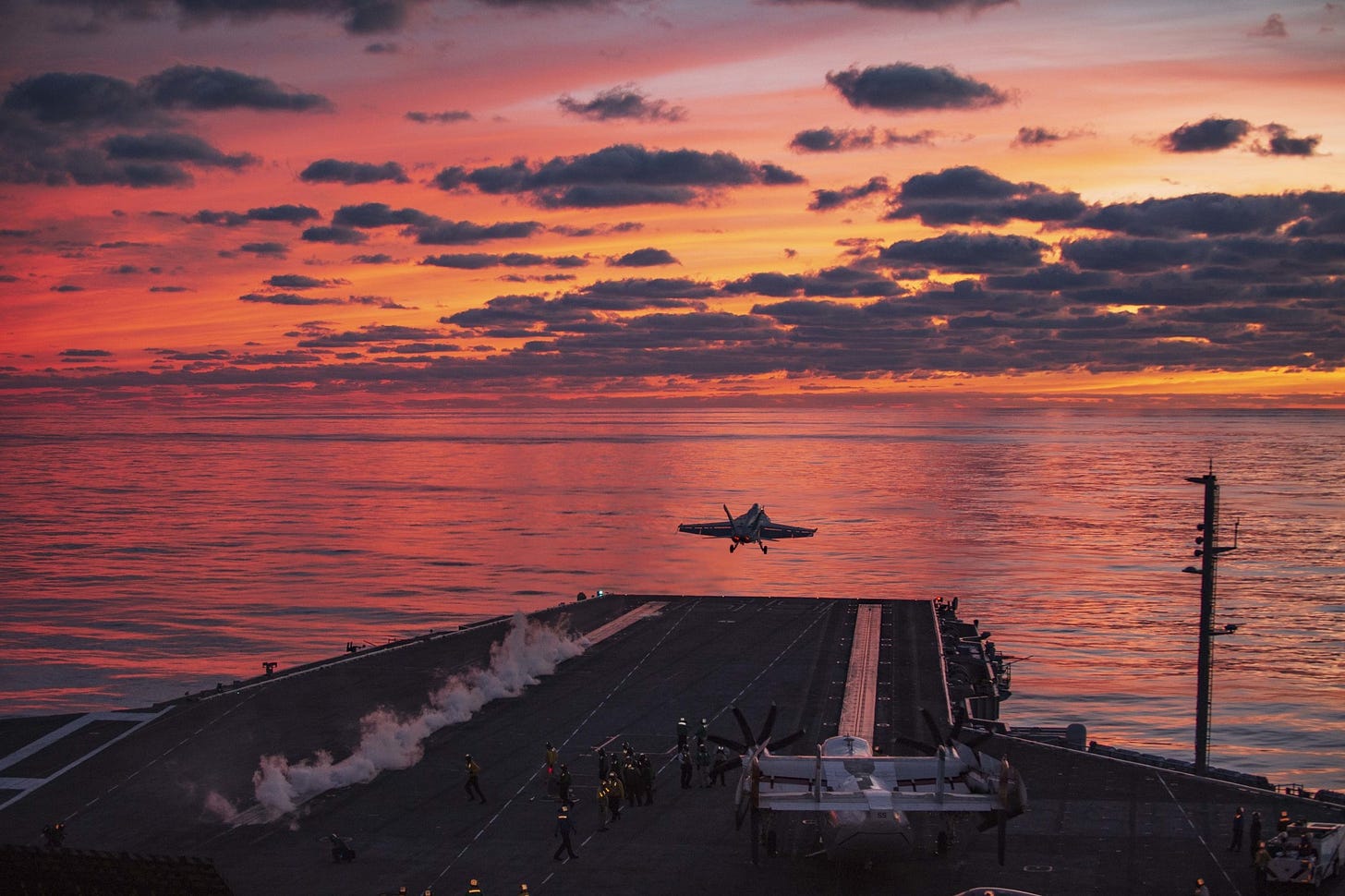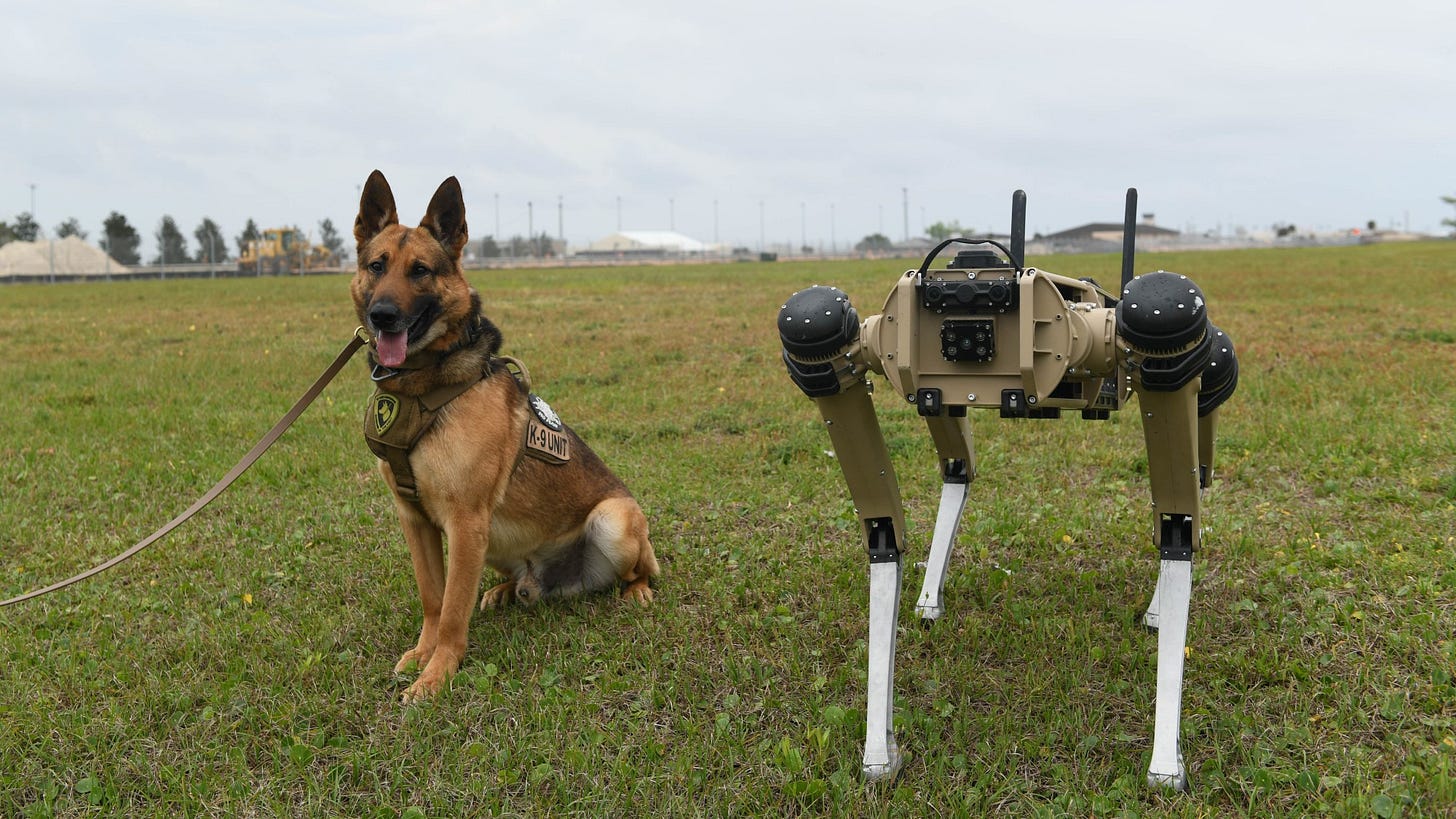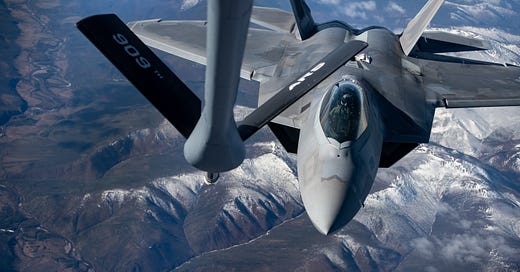Public Domain Warfare
A guest post from, and interview with, Paul Musgrave on who owns the imagery of war.
For this week’s Wars of Future Past, I asked Paul Musgrave if I could run his excellent essay on “The Military-Photographic Complex,” a great and useful look at how usage rights and image production shapes how we see stories about foreign affairs. If you enjoy what I write, I think you’ll appreciate Paul’s newsletter. For some added depth, I’ve also included a short conversation with Paul about The Military-Photographic Complex, where we get into what this means for academia, journalism, and, heck, even the visual infrastructure of online. This is an image-rich email; if it doesn’t load entirely in your inbox, I recommend viewing it on Substack.
The Military-Photographic Complex
The prospect of domination of the nation's scholars by Federal employment, project allocations, and the power of money is ever present and is gravely to be regarded.
—Dwight D. Eisenhower, Farewell Speech, 1961
When Eisenhower warned that the Cold War meant the military dominated everything, I don’t think he had in mind my Keynote slides. But in a twist, the story the United States government tells the world about itself and its own doings is phenomenally militarized—and because of a quirk of copyright law, that means that much of the visual public domain of the 21st century is a product of the security state.
Okay. Let’s back up.

I care a lot about my lecture slides, and I put a lot of time into making them visually appealing and representative. One reason I care is that I want them to be maximally reusable (only a fool can fail to see that the pivot to video is coming for higher ed sooner or later), and so that means I also care a lot about ensuring that all the images I use are properly licensed. Since I have a budget of, essentially, zero dollars, that means I spend a lot of time on sites that provide free, copyright-free like Pexels, Unsplash, Wikipedia, Flickr’s Creative Commons search, and, given my subject matter, U.S. government Web sites.
Anything produced by the U.S. federal government cannot be copyrighted (state and local governments are a different story). The U.S. federal government also, you may have noticed, produces a lot of intellectual property—all of it, from Census reports to congressional floor speeches to NASA photographs of the Earth to the CIA World Factbook, entering the public domain.
An underappreciated part of this is the audiovisual output of the Department of Defense and how it shapes the literal images of international relations we can use.

The Defense Department employs a large number of military photographers (I don’t know how many, but it must be several hundred at least). Everything they produce is in the public domain. And they produce a lot, made available via Defense.Gov, DVIDS, official Flickr sites, and other outlets.
Much of what they put out is striking, often exciting, even, sometimes, beautiful. They’re frequently incredibly well composed. The DoD’s collection is almost certainly the largest visual corpus about the workings of a foreign policy-relevant topic anywhere. And the pictures are all free.

There are a few other U.S. government agencies that have strong visual presences. NASA, whose photos of, you know,the universe, usually look good, pretty much has a cheat code. The White House tends to have a good visual presence on Flickr. It probably reached its apogee under Pete Souza’s tenure during the Obama administration, and the first year or so of the Trump administration was terrible (amateurishly composed, few in numbers), but by the end even 45 was doing well. And the Biden administration has started strong, even though Covid has made crowd shots a little harder.

But you know who does poorly? Basically everyone else. Okay, it makes sense that CIA doesn’t have a great visual presence on social media. But it’s a shame that the U.S. State Department has a weak visual presence—ooh, it’s a stand-up shot of someone in a suit in a briefing room. (Shout-out to the US mission in Geneva, though, which does pretty well.) The legislative branch is mediocre, reflecting its decentralized nature—the House provides great photographs of the Capitol building, but not of members actually doing work. That’s up to individual members and committees, who can’t individually afford the kind of talent it takes to do great photography on deadline. But even Congress fares better than the “money agencies”. The Treasury Department apparently gave up on updating its Flickr in 2016. USAID offers a bunch of screen captures of Zoom (okay, maybe Webex) meetings. The US Trade Representative has never even bothered to upload anything.
Compare that to what you can get on DVIDS and … it’s no comparison. If you want to visually represent the civilian side of the U.S. government, especially the civilian side of foreign policy, you’re out of luck.
Some of that has to do with the fact that the civilians just don’t have as cool of toys as the Defense Department does. But more of it has to do with the wild disparity in funding for civilian agencies and military/security issues. After all, representing the United States isn’t so boring that you can’t take any good pictures of it.
It may not be literally true that the Defense Department has more band members than the State Department has diplomats, but those numbers are in the same ballpark—and that gives you a sense of the disparity of resources put into war and peace, respectively. The visual disparity is even more striking.

And all of this brings us back to how this disparity affects the public domain. The images and videos in the public domain are the tools that we have to tell our story (unless our resources include a Getty subscription). They’re overwhelmingly militarized. And that means it’s easier to show—and tell—a militarized story.
This is not, actually, a niche complaint. In a visual world, being on Flickr—or more modern social networks, from TikTok to Instagram—is how people communicate. Even Chechen leader Ramzan Kadyrov understands this (or did, before he was suspended). Bolstering how the U.S. presents its civilian foreign policy—and civilian agencies more generally—would help to tell different stories, both to the world and to us.
A Conversation
Kelsey: So, let’s start at the beginning. What was it that led you to consider the free visuals from the Pentagon as worth further investigation and explanation?
Paul: A lot of times, academics begin an essay from some lofty theoretical stance. This essay had the opposite process: I noticed the other day that I’ve been so habituated to finding good images on DoD Flickr sites (sometimes DVIDS or Defense.gov, but mostly Flickr) that I’ve basically given up looking for civilian foreign-policy imagery. That’s kind of weird! A big thrust of my courses is to try to make sure that people don’t just assume that foreign policy is national security, and I try hard to balance the inevitable interest in defense and security issues with ways of showing that U.S. foreign policy isn’t totally militarized. But photos on civilian Web sites--like State or Treasury--are just so bad: badly composed, unimaginative, totally uninteresting. And I started to think about why that was, and why that mattered.
Kelsey: As someone who covers military tech across the world, I should also say that the vast array of public-domain images of military material (and, well, materiel) is heavily biased towards the United States, especially for what’s available to an English-speaking audience. Images transcend language barriers but deciphering terms of use certainly doesn’t.
There’s some militaries that have available galleries, but even the United Kingdom’s Ministry of Defence has stricter use terms than the Department of Defense. One immediate application is that I wrote three robot stories for Popular Science back-to-back: two on American military robots, one on a Russian machine. For the US, the pictures were easy, clear, and well composed. One of them even had multiple angles to choose from. For the Russian drone, I had the option of YouTube screenshots of video of it in flight, or a high resolution picture of an inhabited fighter jet which flies in conjunction with that drone. Out of an abundance of caution on usage rights, we went with the second.

Which is what I wanted to ask next: beyond the public domain availability of US military images, do you think the possibility of legal challenges to fair use of images has any constraining effect on how this topic can be illustrated?
Paul: I think there’s a big issue here, and it’s one most consumers are unaware of unless they’re also aware of how rights shape everything online. I’m incredibly careful about rights issues because the long-term dangers of ignoring them are huge--companies can and will go after you, and the marriage of AI and lawsuits to enforce rights (and that’s got to be the next stage after automatic content curation) probably is a lot closer than a true self-driving car at this point. The chilling effect exerts a profound deterrent force, to the point that I often face a choice between having an unrepresentative photo or none at all unless I want to break copyright. (I know a lot of academics are casual about rights issues, but I think this is a sloppy practice they should break because IP protections are pretty strong and seem unlikely to grow weaker.)
The situation you describe is one I’ve faced a lot. How do you illustrate a lecture about peacekeeping? How do you illustrate a lecture about sanctions? Or even drone strikes in Pakistan? The closer your topic is to the publicly-acknowledged, routine actions of the uniformed U.S. military, the easier it is to find high-quality graphics you can use. The farther away, the more impossible it becomes very quickly, even with allied forces. And then we get into simple questions of state capacity and funding if you want to have pictures from the Global South.

People used to say that “information wants to be free” but my J. Paul Getty-esque retort is that “rights want to be expensive”. (I mean, it’s no surprise that Getty is now best known for owning ...images.) So in one sense it’s wonderful--really--that NASA and DOD make all of this stuff available for free and rights-cleared. Just glancing at the academic books on my shelf, it would basically be impossible to illustrate contemporary natsec issues without those resources. But we can also tell and re-tell the stories that the Pentagon and other official outlets want us to have access to, even if that’s not their conscious intention, unless we have the resources to spring for Getty or other licenses. (This is one of the enduring reasons that places like legacy media outlets look so much consistently better than underfunded places--amortizing a monthly Getty license across a whole organization is way cheaper than trying to scrounge $30/picture.)
Kelsey: That leads nicely to where I wanted to start wrapping this up. I don’t know the specifics of intellectual property law regarding, like, lecture slides, but I can speak a little to a range of approaches to acquiring images for online publication. The casualness and ease of using screenshots and creative commons licenses for web publication has, at least in my experience, shrunk dramatically in the last five years. I’m inclined, narratively, to attribute this to the chilling effect of the Thiel-sponsored lawsuit that broke Gawker, though it could just as easily be the proliferation of private equity ownership of media. Part of that might be an aversion to risk, but I think even more broadly it's an aversion to cost.
I don’t expect any legacy media to start cutting access to Getty images, at least not until the next abrupt media downturn, but I also don’t really see, like, Substack offering access to a Getty image pool as a resource for writers any time. Which means that, in the newest new media spaces like, er, our newsletters, we’re even more on the hook for fronting image costs ourselves, risking legal liability through an IP-scanning AI not understanding Fair Use, or defaulting to public domain.
There are plenty of ways that the Pentagon actively works to shape public perception, from curating specific media coverage or stipulating content-related usage agreements for the use of its military equipment film. With image rights, instead, we’re seeing a great crowding-out of what was, even a decade ago, an array of other low-cost options to illustrate stories of military and foreign policy. To win Public Domain Warfare, all the Pentagon needs is for no one else to play.
Paul: I think this is exactly right. Broadly, the rights issues are the same; someone’s going to say “but what about fair use” or whatever, and, buddy, that’s a defense if you get sued, not a get-out-of-jail-free card, so it’s easier to stick with CC0 or US government works. (Even the various flavors of CC get annoying, since they may require you to make your own derivative works licensed in the same way and it’s tough to keep track of what you’re actually doing.) That’s why Pexels and Unsplash and the like buy freelancers’ work and make them available--and it’s also why they’re doing so on the same principle that your dealer will give you the first hit for free; who hasn’t looked at the beautifully composed stock art in the premium gallery previews and wanted to reach for their credit card?

And this is why the best path forward would be for the U.S. and other governments to really take seriously what they’re putting out there. I mean, it’s a big Twitter joke right now to say “everything is infrastructure”, but public-domain images and video really are infrastructure for intellectual property. Fortunately, they’re cheap and enduring. Having a Works Progress Administration or some other New Deal-inspired art project to capture America and its government would literally be a stimulus to media and creators alike--and it’s a gift that would last for generations.
Thank you all for reading this. I do genuinely enjoy writing these newsletters every fortnight, and I will keep writing them in some form for as long as I can sustain myself doing so.
That said, there’s a lot up in the air about my continuing to keep this at Substack. I’ve got inclinations, and plenty of people I respect have parted with the company for clear and sound reasons. Before I make the decision, though, I want to hear from you, and to that end Alymay and I put together a survey so I can better understand what you hope to get out of Wars of Future Past.
This survey link will be open until April 30th, 2021. Sometime not too long after that, I’ll make a call about staying at Substack or porting this whole production elsewhere. As a reader and a subscriber, very little will change on your end if I do make the change, but I want to be above-board before making it.
If you’re in the mood for more free newsletters, may I recommend checking out what we’re doing over at Discontents? It will remain free while at Substack, and you can see us channel our collective newsletter lucre into this exquisitely grotesque image commissioned from Eli Valley.



